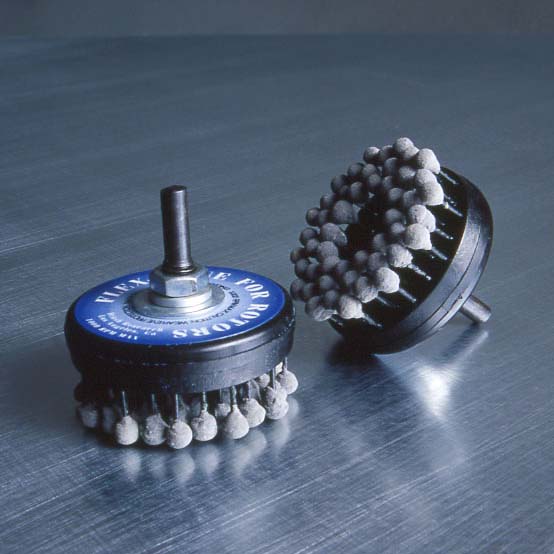Somewhat resembling a spinning bottlebrush, this tool is characterized by abrasive globules that are permanently mounted to flexible filaments that are attached to a center shaft.
Contributed by | Brush Research Manufacturing
For years the flexible, ball-style hone has dominated the market for applications that require honing of cylindrical metal surfaces such as engine piston bores and drilled through-holes. Now the tool, in a slightly different configuration but with the same filaments and abrasive globules, is increasingly being utilized on two-dimensional, or planar, surfaces.
This is opening up possibilities for applications in which hardened metals interact or mate in surface-to-surface friction with other metals or materials. Examples include sliding guideways, flywheels, brake rotors and others.
“The same type of surface we have promoted and produced for years for internal cylinders also has validity for flat surfaces,” says Jonathan Borden, National Sales Manager of Brush Research Manufacturing. The abrasive technology company is known for inventing the Flex-Hone Tool and turning it into a global brand.

Known widely as a tool used for de-burring, plateau honing and deglazing, the Flex-Hone is a highly versatile tool used for a variety of machining operations. Somewhat resembling a spinning bottlebrush, this tool is characterized by abrasive globules that are permanently mounted to flexible filaments that are attached to a center shaft. This extremely flexible, low-cost tool can be used for sophisticated surfacing, de-burring, edge-blending and cleaning.
In the automotive industry, for example, cylinder hones are often utilized for creating an effective surface finish on engine cylinders. Engine cylinders have surface-to-surface contact with pistons sliding against the wall. To reduce power losses from friction, engine cylinders are honed so piston rings can seat properly as well as to allow for lubrication flow and oil retention on the walls of the cylinder.
According to Borden, the principles behind cylinder honing apply also to flat, or planar, surfaces.
Borden says the process was recently put the test for sliding guideways, a critical structural component of CNC machines. These guideways provide the smooth, linear motion of the machine tools along its predetermined path. It is therefore fundamental to the accuracy and precision that can be achieved with this type of equipment.
The goal of the study was to establish if Cubic Boron Nitride (CBN) milling tools followed by a secondary planar honing operation could replace the traditional grinding process used to manufacture the hardened cast iron guideways. The experiment and subsequent conclusions were outlined in a published article in the Journal of Manufacturing Science and Engineering, July 2017 issue.
The article, entitled “Optimization of Planar Honing Process for Surface Finish of Machine Tool Sliding Guideways” was authored by Kory Chang and Masakazu Soshi of the Advanced Research for Manufacturing Systems (ARMS) Laboratory in the Department of Mechanical and Aerospace Engineering at the University of California, Davis.
As the foundation for linear motion, the surface finish on sliding guideways is a critical factor. A poor surface finish can shorten CNC tool life, increase power consumption and cause errors in tool position, resulting in out of tolerance workpieces.
However, the traditional grinding process for manufacturing sliding guideways involves removing, cleaning, and then repositioning parts several times. The hardened surfaces, which measure as high as 50-60 on the Rockwell C Scale, also require grinding because milling cutters typically wear out too quickly.
Instead, an alternative utilizing Cubic Boron Nitride (CBN) milling tools along with a secondary planar honing operation was proposed in the design experiment. CBN is one of the hardest known materials for machining of steels and cast iron. Unfortunately, the milling process does not create a consistent surface finish.
For that, planar honing would be used within the same machining center. According to the study, the Flex-Hone for Rotors from Brush Research Manufacturing was selected as the tool for the research. The planar honing tool provides a low-temperature abrading process that exposes the undisturbed base metal.
Unlike the “bottlebrush” design used to hone cylinders, the planar honing tool utilizes the same type of filaments with abrasive globules mounted to a disc. The tool can be held in a collet, chuck, or similar holding device.
To achieve the optimal finish, a 400 and 600-grit silicon carbide Flex-Hone for Rotors was selected after it was determined that a fine grain size was all that was required to flatten and create the plateau peaks on the cast iron sliding guideways.
The Flex-Hone tool, along with other factors such as pressure, spindle speed, feed rate and number of strokes, was expected to produce a surface finish in the 0.3–0.6 lm and 0.2–0.3 lm were the respective Ra range.
The experiment study concluded that the “analysis showed that the ideal plateau finish desired on the hardened cast iron was supported by both measured real parameters and the Abbott–Firestone curve.”
According to Borden, sliding guideways is only one example of the type of surfaces that could benefit from planar honing.
“Others applications that have already benefitted from this type of hone include automotive and motorcycle disc brake rotors, fly wheels and clutch plates,” says Borden.
The content & opinions in this article are the author’s and do not necessarily represent the views of ManufacturingTomorrow
Comments (0)
This post does not have any comments. Be the first to leave a comment below.
Featured Product


